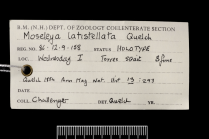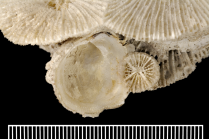WoRMS taxon details
Moseleya Quelch, 1884
267601 (urn:lsid:marinespecies.org:taxname:267601)
accepted
Genus
Moseleya latistellata Quelch, 1884 (type by monotypy)
- Species Moseleya latistellata Quelch, 1884
- Species Moseleya minor Ma, 1959 (uncertain > taxon inquirendum)
marine, fresh, terrestrial
Quelch, J.J. 1884. Preliminary notice of new genera and species of Challenger reef-corals. Annals and Magazine of Natural History, 5th Series 13: 292-297. [details]
Description 'Corallum compound, flattened, or slightly and broadly convex. Young calicles developing by calicinal marginal budding...
Description 'Corallum compound, flattened, or slightly and broadly convex. Young calicles developing by calicinal marginal budding around a very large median calicle, which has very numerous septal orders, the calicles becoming polygonal and deep at the centre. Epitheca very slight; wall very thin and almost rudimentary, but developed so as to give a distinct simple line of separation to the calicles on the surface, often interrupted, seen in section in a very rudimentary state separating the calicinal centres. Costæ very distinct, thin, and finely denticulate. Septa often confluent and continuous from centre to centre in the line of union between adjoining calicles, very thin and close, finely tooth above, and having the teeth subequal or slightly larger near the centre. Endothecal dissepiments vesicular, very abundantly developed, leaving but a very small portion of the septa free exteriorly, seen in transverse section forming nearly concentric lines, and more or less complete tabulæ at the centre. A false columella present, seen exteriorly to be formed by the trabeculate and vermiform nature of the innermost upper part of the septa, entirely or almost absent in transverse section, where the septa are seen to meet almost at a point.' (Quelch, 1884: 292–293) [details]
Hoeksema, B. W.; Cairns, S. (2024). World List of Scleractinia. Moseleya Quelch, 1884. Accessed through: World Register of Marine Species at: https://www.marinespecies.org/aphia.php?p=taxdetails&id=267601 on 2024-05-20
Date
action
by
![]() The webpage text is licensed under a Creative Commons Attribution 4.0 License
The webpage text is licensed under a Creative Commons Attribution 4.0 License
original description
Quelch, J.J. 1884. Preliminary notice of new genera and species of Challenger reef-corals. Annals and Magazine of Natural History, 5th Series 13: 292-297. [details]
context source (Hexacorallia) Fautin, Daphne G. (2013). Hexacorallians of the World. (look up in IMIS) [details]
basis of record van der Land, J. (ed). (2008). UNESCO-IOC Register of Marine Organisms (URMO). , available online at http://www.marinespecies.org/urmo/ [details]
additional source Veron JEN, Pichon M, Wijsman-Best M. (1977). Scleractinia of Eastern Australia – Part II. Families Faviidae, Trachyphylliidae. <em>Australian Institute of Marine Science Monograph series.</em> 3: 1-233. [details]
additional source Veron JEN. (2000). Corals of the World. Vol. 1–3. <em>Australian Institute of Marine Science and CRR, Queensland, Australia.</em> [details]
additional source Budd AF, Fukami H, Smith ND, Knowlton N. (2012). Taxonomic classification of the reef coral family Mussidae (Cnidaria: Anthozoa: Scleractinia). <em>Zoological Journal of the Linnean Society.</em> 166 (3): 465-529., available online at https://doi.org/10.1111/j.1096-3642.2012.00855.x [details]
additional source Arrigoni R, Terraneo TI, Galli P, Benzoni F (2014) Lobophylliidae (Cnidaria, Scleractinia) reshuffled: Pervasive . non-monophyly at genus level. Molecular Phylogenetics and Evolution 73: 60-64. [details]
additional source Duncan PM (1884) A revision of the families and genera of the sclerodermic Zoantharia, Ed. & H., or Madreporaria (M. Rugosa excepted). Journal of the Linnean Society of London, 18: 1-204. [details]
additional source Huang D, Arrigoni R, Benzoni F, Fukami H, Knowlton N, Smith ND, Stolarski J, Chou LM, Budd AF. (2016). Taxonomic classification of the reef coral family Lobophylliidae (Cnidaria: Anthozoa: Scleractinia). <em>Zoological Journal of the Linnean Society.</em> 178(3): 436-481., available online at https://doi.org/10.1111/zoj.12391 [details]
context source (Hexacorallia) Fautin, Daphne G. (2013). Hexacorallians of the World. (look up in IMIS) [details]
basis of record van der Land, J. (ed). (2008). UNESCO-IOC Register of Marine Organisms (URMO). , available online at http://www.marinespecies.org/urmo/ [details]
additional source Veron JEN, Pichon M, Wijsman-Best M. (1977). Scleractinia of Eastern Australia – Part II. Families Faviidae, Trachyphylliidae. <em>Australian Institute of Marine Science Monograph series.</em> 3: 1-233. [details]
additional source Veron JEN. (2000). Corals of the World. Vol. 1–3. <em>Australian Institute of Marine Science and CRR, Queensland, Australia.</em> [details]
additional source Budd AF, Fukami H, Smith ND, Knowlton N. (2012). Taxonomic classification of the reef coral family Mussidae (Cnidaria: Anthozoa: Scleractinia). <em>Zoological Journal of the Linnean Society.</em> 166 (3): 465-529., available online at https://doi.org/10.1111/j.1096-3642.2012.00855.x [details]
additional source Arrigoni R, Terraneo TI, Galli P, Benzoni F (2014) Lobophylliidae (Cnidaria, Scleractinia) reshuffled: Pervasive . non-monophyly at genus level. Molecular Phylogenetics and Evolution 73: 60-64. [details]
additional source Duncan PM (1884) A revision of the families and genera of the sclerodermic Zoantharia, Ed. & H., or Madreporaria (M. Rugosa excepted). Journal of the Linnean Society of London, 18: 1-204. [details]
additional source Huang D, Arrigoni R, Benzoni F, Fukami H, Knowlton N, Smith ND, Stolarski J, Chou LM, Budd AF. (2016). Taxonomic classification of the reef coral family Lobophylliidae (Cnidaria: Anthozoa: Scleractinia). <em>Zoological Journal of the Linnean Society.</em> 178(3): 436-481., available online at https://doi.org/10.1111/zoj.12391 [details]
 Present
Present  Inaccurate
Inaccurate  Introduced: alien
Introduced: alien  Containing type locality
Containing type locality
From editor or global species database
Comparison There are two autapomorphies that unambiguously define this monotypic genus. Moseleya has fused walls and weakly or moderately developed paliform (uniaxial) lobes, though this is sometimes absent. These traits clearly distinguish Moseleya from the closely-related Sclerophyllia, with which it forms a poorly-supported clade based on molecular and morphological data. Other characters that are present in Moseleya but not in Sclerophyllia include confluent costosepta, reduced epitheca and medium tooth spacing (0.3–1.0 mm). Moseleya can easily be mistaken as a Pacific 'faviid' (Merulinidae) as it possesses relatively thin walls and costosepta, and has indeed been placed in Faviidae since Vaughan and Wells (1943: 170) until as recently as Veron (2000, vol. 3: 269; see also Wells, 1955). However, it possesses several key traits that place it firmly within Lobophylliidae, including irregular tooth tip at midcalice that are orientated parallel to the septum, unequal tooth shape between the first and third order septa, as well as > 0.6 and > 0.5 mm separating the costa and septum centre clusters respectively. [details]Description 'Corallum compound, flattened, or slightly and broadly convex. Young calicles developing by calicinal marginal budding around a very large median calicle, which has very numerous septal orders, the calicles becoming polygonal and deep at the centre. Epitheca very slight; wall very thin and almost rudimentary, but developed so as to give a distinct simple line of separation to the calicles on the surface, often interrupted, seen in section in a very rudimentary state separating the calicinal centres. Costæ very distinct, thin, and finely denticulate. Septa often confluent and continuous from centre to centre in the line of union between adjoining calicles, very thin and close, finely tooth above, and having the teeth subequal or slightly larger near the centre. Endothecal dissepiments vesicular, very abundantly developed, leaving but a very small portion of the septa free exteriorly, seen in transverse section forming nearly concentric lines, and more or less complete tabulæ at the centre. A false columella present, seen exteriorly to be formed by the trabeculate and vermiform nature of the innermost upper part of the septa, entirely or almost absent in transverse section, where the septa are seen to meet almost at a point.' (Quelch, 1884: 292–293) [details]
Diagnosis Colonial; submassive or massive. Budding intracalicular and extracalicular. Corallites may be polymorphic; discrete. Monticules absent. Walls fused. Calice width large (> 15 mm), with high relief (> 6 mm). Costosepta mostly confluent. Septa in ≥ four cycles (≥ 48 septa). Free septa irregular. Septa spaced < 6 septa per 5 mm. Costosepta unequal in relative thickness. Columellae trabecular and spongy (> three threads), < 1/4 of calice width, and discontinuous among adjacent corallites with lamellar linkage. Paliform (uniaxial) lobes weakly or moderately developed if present. Epitheca reduced. Endotheca usually low-moderate (tabular), but may be abundant. Tooth base at midcalice elliptical-parallel. Tooth tip orientation parallel. Teeth tall (> 0.6 mm). Tooth spacing medium (0.3–1.0 mm), with > six teeth per septum. Tooth shape unequal between first and third order septa. Tooth size equal between wall and septum. Granules scattered on septal face; irregular in shape. Interarea palisade. Walls formed by dominant paratheca and partial septotheca. Thickening deposits in concentric rings with extensive stereome. Costa centre clusters strong; > 0.6 mm between clusters; medial lines weak. Septum centre clusters weak; > 0.5 mm between clusters; medial lines weak. [details]
Remark The genus was established by Quelch (1884: 292) based on material collected from the HMS Challenger expedition at Torres Strait, Australia. It was named in honour of Henry Nottidge Moseley, a British naturalist on the expedition, and placed within a new subfamily Moseleyinæ. It is the senior homonym of the grenadier fish Moseleya Goode and Bean, 1895, named after the same Challenger naturalist, but which has been replaced by Coryphaenoides Gunnerus, 1765. Moseleya latistellata Quelch, 1884: 293, remains the only species to have been described in this genus, and is the type by monotypy. Vaughan and Wells (1943: 170) transferred Moseleya into Faviidae Gregory, 1900, and subsequent authors have followed suit (Wells, 1956; Veron et al., 1977; Wood, 1983; Veron, 1986, 2000; Veron and Marsh, 1988). However, the first molecular data for Moseleya latistellata presented by Huang et al. (2011) showed that it is nested in the clade XIX+XX (sensu Fukami et al., 2008), later classified as Lobophylliidae Dai and Horng, 2009. Budd et al. (2012) then formally transferred the genus into Lobophylliidae in the first monograph of the present series. Analyses with expanded taxon sampling have continually supported this classification (Huang, 2012; Arrigoni et al., 2012, 2014b, c, 2015; Huang and Roy, 2013, 2015), and so has independent analyses using morphological data (Huang et al., 2014b). Moseleya is restricted to the reefs of central Indo-Pacific between southern Taiwan and northern Australia (Veron, 2000). [details]






